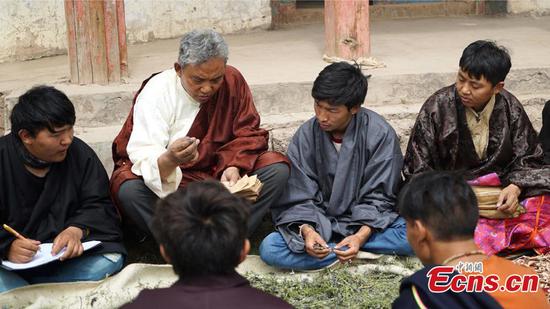
Ancient human habitation found in a village of Nyingchi, Tibet. (Photo/China News Service)
Chinese archaeologists have uncovered the oldest signs of human activity on the Qinghai-Tibet Plateau at about 4,600 meters above sea level, showcasing the astonishing resilience of early humans who inhabited one of Earth's harshest environments tens of thousands of years earlier than expected.
Researchers from the Institute of Vertebrate Paleontology and Paleoanthropology of the Chinese Academy of Sciences have found more than 3,600 stone artifacts made from black slate at Nwya Devu, which is in the Changthang region of the Tibet autonomous region, about 300 kilometers northwest of the capital, Lhasa.
Most of the tools that were found underground were made around 30,000 to 40,000 years ago during the Stone Age. The toolmakers, whose identity remains a mystery, crafted blades and arrowlike flakes of stone, some of which are up to 20 centimeters long.
This makes the site the oldest and highest-altitude evidence of human occupation on "the roof the world", one of the monikers given to the highest plateau on Earth, with an average altitude of 4,000 meters, according to the study published on Friday in the journal Science.
Due to its high altitude, thin air, lack of resources and extremely cold weather, the Qinghai-Tibet Plateau is one of the last regions to be colonized by early humans in Asia, and it remains one of the planet's least-populated areas.
Archaeologists previously estimated that hunter-gatherer humans were living on the margins of the plateau about 15,000 years ago. People only began settling permanently on the plateau about 3,600 years ago, after they had mastered yak and sheep herding, as well as the cultivation of barley, one of the staple foods of today's residents of Tibet.
Bai Chunli, president of the academy, said in a statement about the discovery that the new finding has great scientific significance in expanding understanding of prehistoric humans' migration patterns and adaptation to different environments.
It also has great social significance in studying the origin of native people and their culture, as well as facilitating the preservation and protection of Tibetan artifacts and cultural resources, Bai said.
Gao Xing, a researcher from the CAS institute, said Nwya Devu qualifies as a national-level archaeological site with huge research interests, and government agencies at various levels will need to protect the area from potential artifact scavengers and other disturbances.
"We still need to find animal, plant or human remains in the area to collect DNA samples that can answer some of our biggest questions, such as who are these prehistoric humans and how did they survive in this challenging environment?"
Researchers speculate that the toolmakers used Nwya Devu as a seasonal workshop and camping site. Hunter-gatherer groups might have followed herds of animals onto the plateau and camped for weeks at a time at the site, which was also near several lakes where migratory birds rested.
"There are still so many questions, and the artifacts we discovered might just be the tip of the iceberg," Gao said. "If we can find other evidence of human activities, like a campsite or a fireplace, it will help clarify matters."


















































